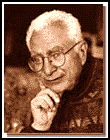
of the Santa Fe Institute,
and 1969 Nobel Laureate
"The Quark and the Jaguar: from Simplicity to Complexity"
Wednesday, May 14th, 1997
In 1953 Gell-Mann began to develop some of the theories that, verified experimentally over the subsequent 40 years, would earn him the Nobel Prize in Physics in 1969. His theory of the "eightfold way" restored order to the chaos created with the discovery of some 100 new particles in the atomic nucleus. However, Gell-Mann is best known for his theory predicting the even more elementary particles he dubbed "quarks", a discovery which sparked the development of a new branch of physics known as quantum chromodynamics.
His interests extend to many other subjects, including archaeology, history, evolutionary biology, linguistics, learning and creative thinking. He is a founding member of the Santa Fe Institute, where he is currently involved in the study of the similarities and differences between complex adaptive systems (which develop using information gathered from the environment), which brings all of these subjects together.